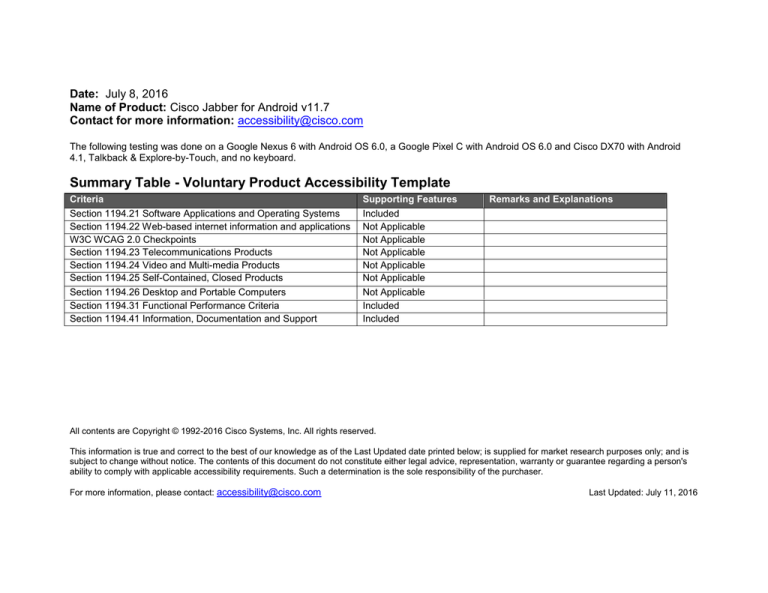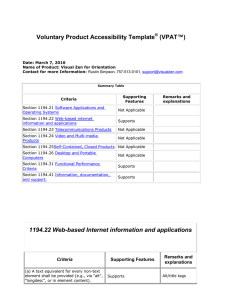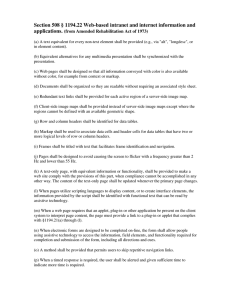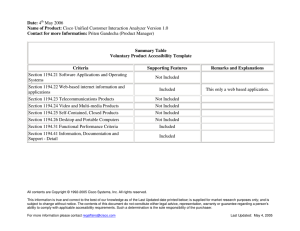
Date: July 8, 2016
Name of Product: Cisco Jabber for Android v11.7
Contact for more information: accessibility@cisco.com
The following testing was done on a Google Nexus 6 with Android OS 6.0, a Google Pixel C with Android OS 6.0 and Cisco DX70 with Android
4.1, Talkback & Explore-by-Touch, and no keyboard.
Summary Table - Voluntary Product Accessibility Template
Criteria
Section 1194.21 Software Applications and Operating Systems
Section 1194.22 Web-based internet information and applications
W3C WCAG 2.0 Checkpoints
Section 1194.23 Telecommunications Products
Section 1194.24 Video and Multi-media Products
Section 1194.25 Self-Contained, Closed Products
Section 1194.26 Desktop and Portable Computers
Section 1194.31 Functional Performance Criteria
Section 1194.41 Information, Documentation and Support
Supporting Features
Included
Not Applicable
Not Applicable
Not Applicable
Not Applicable
Not Applicable
Not Applicable
Included
Included
Remarks and Explanations
All contents are Copyright © 1992-2016 Cisco Systems, Inc. All rights reserved.
This information is true and correct to the best of our knowledge as of the Last Updated date printed below; is supplied for market research purposes only; and is
subject to change without notice. The contents of this document do not constitute either legal advice, representation, warranty or guarantee regarding a person's
ability to comply with applicable accessibility requirements. Such a determination is the sole responsibility of the purchaser.
For more information, please contact: accessibility@cisco.com
Last Updated: July 11, 2016
Version of the Product
V 11.7.0.x on Samsung SM-G9200
All contents are Copyright © 1992-2016 Cisco Systems, Inc. All rights reserved.
This information is true and correct to the best of our knowledge as of the Last Updated date printed below; is supplied for market research purposes only; and is
subject to change without notice. The contents of this document do not constitute either legal advice, representation, warranty or guarantee regarding a person's
ability to comply with applicable accessibility requirements. Such a determination is the sole responsibility of the purchaser.
For more information, please contact: accessibility@cisco.com
Last Updated: July 11, 2016
V 11.7.0.x on Google Pixel C
All contents are Copyright © 1992-2016 Cisco Systems, Inc. All rights reserved.
This information is true and correct to the best of our knowledge as of the Last Updated date printed below; is supplied for market research purposes only; and is
subject to change without notice. The contents of this document do not constitute either legal advice, representation, warranty or guarantee regarding a person's
ability to comply with applicable accessibility requirements. Such a determination is the sole responsibility of the purchaser.
For more information, please contact: accessibility@cisco.com
Last Updated: July 11, 2016
Section 1194.21: Software Applications and Operating Systems – Detail
508 Clause
1194.21(a)
Criteria
When software is designed to run on a system that has a
keyboard, product functions shall be executable from a
keyboard where the function itself or the result of performing
a function can be discerned textually.
Status
Supports with
Exceptions
1194.21(b)
Applications shall not disrupt or disable activated features of
other products that are identified as accessibility features,
where those features are developed and documented
according to industry standards. Applications also shall not
disrupt or disable activated features of any operating system
that are identified as accessibility features where the
application programming interface for those accessibility
features has been documented by the manufacturer of the
operating system and is available to the product developer.
A well-defined on-screen indication of the current focus shall
be provided that moves among interactive interface elements
as the input focus changes. The focus shall be
programmatically exposed so that Assistive Technology can
track focus and focus changes.
Sufficient information about a user interface element
including the identity, operation and state of the element
shall be available to Assistive Technology. When an image
represents a program element, the information conveyed by
the image must also be available in text.
Supports
When bitmap images are used to identify controls, status
indicators, or other programmatic elements, the meaning
assigned to those images shall be consistent throughout an
application's performance.
Supports
1194.21(c)
1194.21(d)
1194.21(e)
Remarks and Explanations
OS provides on-screen
keyboard. User can also use
Explore-by-touch to
navigate. User cannot
navigate to some elements
using gestures.
Supports with
Exceptions
The emoticon panel in the
chat screen has no focus on
the Tablet.
Supports with
Exceptions
Duplicate screen reader for
chat session in file transfer
and voicemail list;
All contents are Copyright © 1992-2016 Cisco Systems, Inc. All rights reserved.
This information is true and correct to the best of our knowledge as of the Last Updated date printed below; is supplied for market research purposes only; and is
subject to change without notice. The contents of this document do not constitute either legal advice, representation, warranty or guarantee regarding a person's
ability to comply with applicable accessibility requirements. Such a determination is the sole responsibility of the purchaser.
For more information, please contact: accessibility@cisco.com
Last Updated: July 11, 2016
1194.21(f)
Textual information shall be provided through operating
system functions for displaying text. The minimum
information that shall be made available is text content, text
input caret location, and text attributes.
Supports
1194.21(g)
Applications shall not override user selected contrast and
color selections and other individual display attributes.
When animation is displayed, the information shall be
displayable in at least one non-animated presentation mode
at the option of the user.
Supports
1194.21(i)
Color coding shall not be used as the only means of
conveying information, indicating an action, prompting a
response, or distinguishing a visual element.
Supports
Icons can be selected to
replace user status colors
1194.21(j)
When a product permits a user to adjust color and contrast
settings, a variety of color selections capable of producing a
range of contrast levels shall be provided.
Not applicable
There is no functionality
which allows a user to adjust
color and contrast settings.
1194.21(k)
Software shall not use flashing or blinking text, objects, or
other elements having a flash or blink frequency greater than
2 Hz and lower than 55 Hz.
Not applicable
There is no flashing or
blinking objects.
1194.21(l)
When electronic forms are used, the form shall allow people
using Assistive Technology to access the information, field
elements, and functionality required for completion and
submission of the form, including all directions and cues.
Supports
OS provides Talkback
screen-reader and onscreen keyboard
1194.21(h)
Not applicable
Invert colors available on
some devices
There is no animation.
All contents are Copyright © 1992-2016 Cisco Systems, Inc. All rights reserved.
This information is true and correct to the best of our knowledge as of the Last Updated date printed below; is supplied for market research purposes only; and is
subject to change without notice. The contents of this document do not constitute either legal advice, representation, warranty or guarantee regarding a person's
ability to comply with applicable accessibility requirements. Such a determination is the sole responsibility of the purchaser.
For more information, please contact: accessibility@cisco.com
Last Updated: July 11, 2016
Section 1194.31: Functional Performance Criteria – Detail
508 Clause
1194.31(a)
1194.31(b)
1194.31(c)
1194.31(d)
1194.31(e)
1194.31(f)
Criteria
At least one mode of operation and information retrieval that
does not require user vision shall be provided, or support for
Assistive Technology used by people who are blind or visually
impaired shall be provided.
At least one mode of operation and information retrieval that
does not require visual acuity greater than 20/70 shall be
provided in audio and enlarged print output working together or
independently, or support for Assistive Technology used by
people who are visually impaired shall be provided.
At least one mode of operation and information retrieval that
does not require user hearing shall be provided, or support for
Assistive Technology used by people who are deaf or hard of
hearing shall be provided
Where audio information is important for the use of a product, at
least one mode of operation and information retrieval shall be
provided in an enhanced auditory fashion, or support for
assistive hearing devices shall be provided.
At least one mode of operation and information retrieval that
does not require user speech shall be provided, or support for
Assistive Technology used by people with disabilities shall be
provided.
At least one mode of operation and information retrieval that
does not require fine motor control or simultaneous actions and
that is operable with limited reach and strength shall be
provided.
Status
Supports with
Exception
Remarks and Explanations
For exceptions see remarks
for 1194.21 (a) (c) (d)
Supports
OS provides Talkback,
screen reader and visible
focus changes, text size is
adjustable, and Zoom feature
Supports
Supports
Supports
Supports
All contents are Copyright © 1992-2016 Cisco Systems, Inc. All rights reserved.
This information is true and correct to the best of our knowledge as of the Last Updated date printed below; is supplied for market research purposes only; and is
subject to change without notice. The contents of this document do not constitute either legal advice, representation, warranty or guarantee regarding a person's
ability to comply with applicable accessibility requirements. Such a determination is the sole responsibility of the purchaser.
For more information, please contact: accessibility@cisco.com
Last Updated: July 11, 2016
Section 1194.41: Information, Documentation and Support - Detail
508 Clause
1194.41(a)
1194.41(b)
1194.41(c)
Criteria
Product support documentation provided to endusers shall be made available in alternate formats
upon request, at no additional charge
End-users shall have access to a description of the
accessibility and compatibility features of products
in alternate formats or alternate methods upon
request, at no additional charge.
Support services for products shall accommodate
the communication needs of end-users with
disabilities.
Status
Supports
Remarks and Explanations
Accessible documentation is available
through Cisco TAC upon request.
Supports
Accessible documentation is available
through Cisco TAC upon request.
Supports
Cisco conforms through equal
facilitation. Customers may reach Cisco
Technical Assistance Center (TAC) via
Phone, Email or Web Form. All cases
open through email or web are opened
as Priority 3 cases. All Priority 1 or
Priority 2 case can only be opened via
the telephone. TTY users must call the
Text Relay Service (TRS) by dialing 711
or their state Video Relay Service (VRS)
and have the TRS agent contact Cisco
TAC via voice.
All contents are Copyright © 1992-2016 Cisco Systems, Inc. All rights reserved.
This information is true and correct to the best of our knowledge as of the Last Updated date printed below; is supplied for market research purposes only; and is
subject to change without notice. The contents of this document do not constitute either legal advice, representation, warranty or guarantee regarding a person's
ability to comply with applicable accessibility requirements. Such a determination is the sole responsibility of the purchaser.
For more information, please contact: accessibility@cisco.com
Last Updated: July 11, 2016
Supporting Feature (Status) Terminology
The result of “Accessibility Testing" assists in the determination of the Supporting Features.
Supporting Features or Status
Description
Supports
Use this language when you determine the product fully meets the letter and intent of
the Criteria.
Supports with Exceptions
Use this language when you determine the product does not fully meet the letter and
intent of the Criteria, but provides some level of access relative to the Criteria. Please
document the exception in the “Remarks and Explanations” column.
Supports through Equivalent Facilitation
Use this language when you have identified an alternate way to meet the intent of the
Criteria or when the product does not fully meet the intent of the Criteria. Please
document the exception in the “Remarks and Explanations” column.
Supports when combined with Compatible
Assistive Technology
Use this language when you determine the product fully meets the letter and intent of
the Criteria when used in combination with Compatible Assistive Technology. For
example, many software programs can provide speech output when combined with a
compatible screen reader (commonly used assistive technology for people who are
blind). Please document the exception in the “Remarks and Explanations” column.
Does not Support
Use this language when you determine the product does not meet the letter or intent of
the Criteria. Please document the reason in the “Remarks and Explanations” column.
Not Applicable
Use this language when you determine that the Criteria do not apply to the specific
product. For example, many web applications don't have video content the "Not
Applicable" can be used. Please state "The application does not have any video
content" in the “Remarks and Explanations” column. Please document the reason in
the “Remarks and Explanations” column.
All contents are Copyright © 1992-2016 Cisco Systems, Inc. All rights reserved.
This information is true and correct to the best of our knowledge as of the Last Updated date printed below; is supplied for market research purposes only; and is
subject to change without notice. The contents of this document do not constitute either legal advice, representation, warranty or guarantee regarding a person's
ability to comply with applicable accessibility requirements. Such a determination is the sole responsibility of the purchaser.
For more information, please contact: accessibility@cisco.com
Last Updated: July 11, 2016






